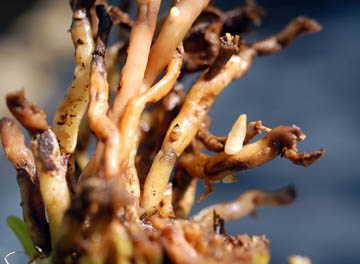Basically the structure of an orchid plant is the same as any plant for it has roots, stems, leaves and flowers. But these parts are adapted to its way of life and differ somewhat from familiar plants which you grow in your garden. Most garden or house plants have a central root system that grows down into the soil and anchors it to the ground. From this central root, smaller, finer roots covered in fine hairs will develop forming the root system of the plant. This underground root system absorbs moisture and nutrients from the soil.
On the other hand, most of the orchids grown by hobbyists are epiphytes. In nature, rather than grow into the ground, epiphytes use their roots to attach themselves to trees or rocks where light and air movement are more plentiful.

The central core of an orchid root is covered by a spongy material called velamen. This spongy material stores water for the plant and should it remain wet for too long, the central core will rot and will no longer be able to absorb moisture and nutrients. If an orchid plant is potted in soil or dirt, the roots will not receive enough air and will be unable to dry out and will rot. In order for an orchid plant to be healthy and produce flowers, water, air and light must be in balance.
These newly emerging Cattleya root tips indicate that it is a good time to repot the orchid if it needs it. The white covering on the mature roots is velamen.
Orchid roots can be very fine such as those of the Oncidium family or very thick like Phalaenopsis or Vanda roots. The thickness of the roots is usually a good measure to determine the type of orchid potting media to use: In general, the thicker the root, the more open and less dense the potting material.
Monopodial orchids often have arial roots that are produced at intervals along the main stem and grow out and down. Some attach to the support, if it is a slab or a totem, some go down into the potting mix in a basket or pot, but many monopodial plant roots hang in the air. Many originate above the lower leaves. Active roots are white with green or brownish tips when in growth. Dry dead roots look like brown strings and may be cut off with a sterile tool if their central core is brown.

Even experienced growers can have trouble distinguishing live roots from dead roots. Sometimes roots that appear to be dead, can still produce live, new roots as shown by the white root tip in this photo.
The roots of sympodial orchids grow from the rhizome. They are white and fleshy with a spongy covering layer. The growing tips are bright green, reddish-brown or olive color. As with roots of all plants, the growing tip is pushed forward by the division of the cells immediately behind it.
Roots take up water and nutrients for the growth of the plant. On orchids they also serve as holdfasts, attaching themselves to the insides of containers, into the slabs of cork or tree fern, or even attaching to the plastic peanuts used for drainage material in pots. Roots often venture over the edges of pots or baskets, hanging out in the air as they do in nature.
When growing in the wild, roots may secure themselves in the cracks of bark or rocks. They absorb water and nutrients from the debris that collects around them.
Old roots on a plant may cease to function and turn brown and dry or brown and soggy. These may be cut off with a sterile tool or razor blade. However, as long as roots have a green core, they are useful, and experiments show that old live roots take up as much nourishment as do new roots.

